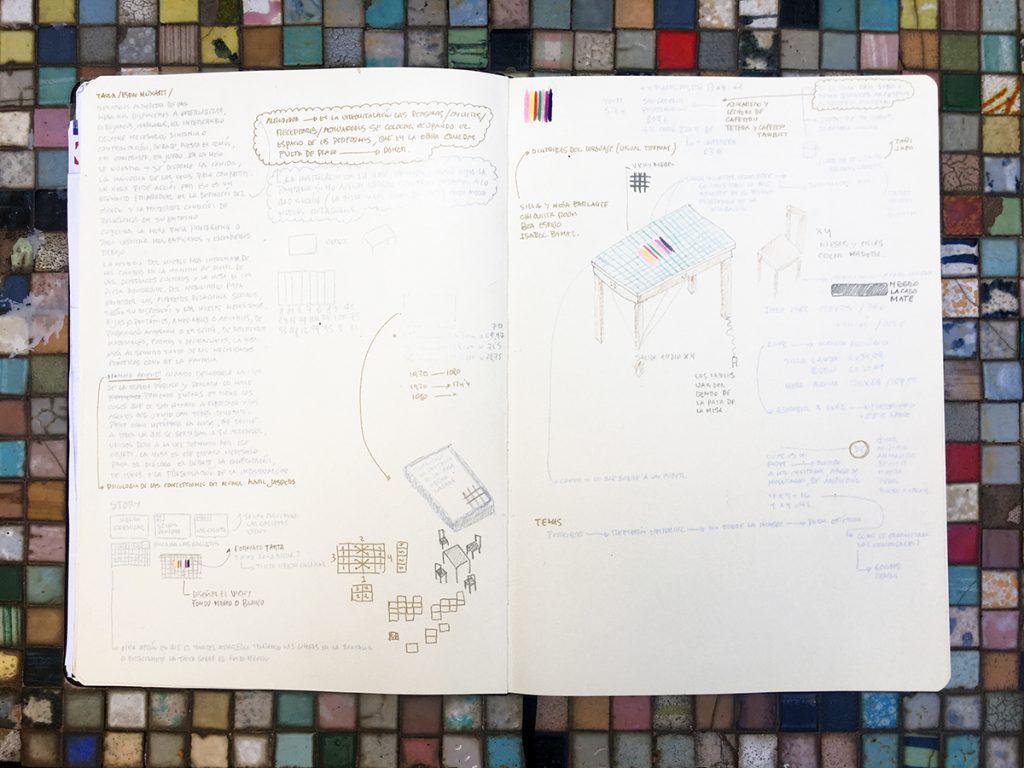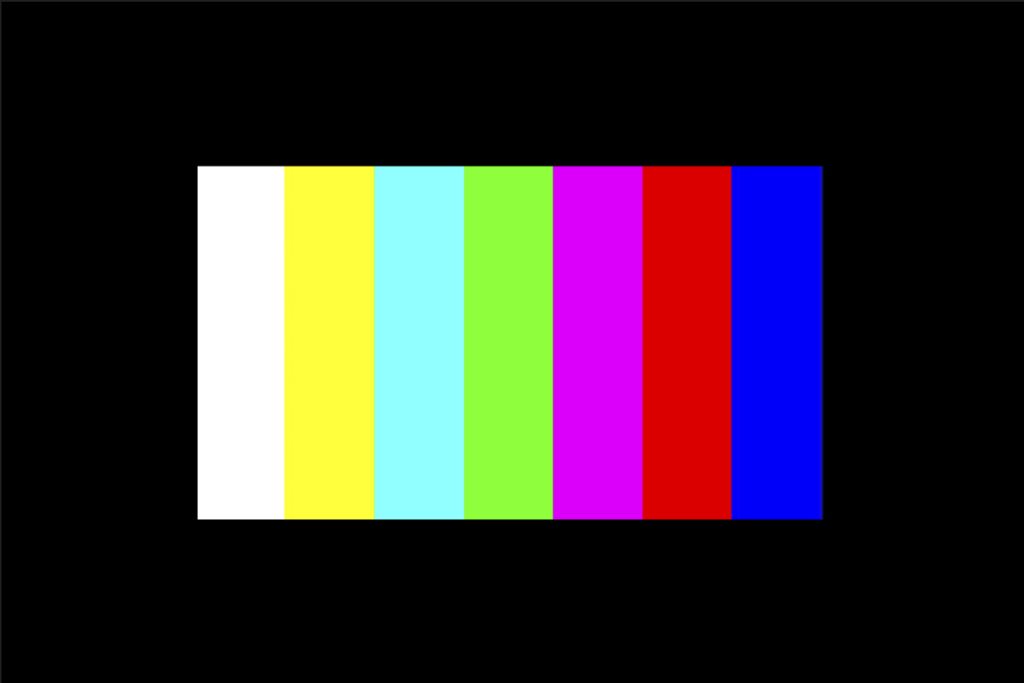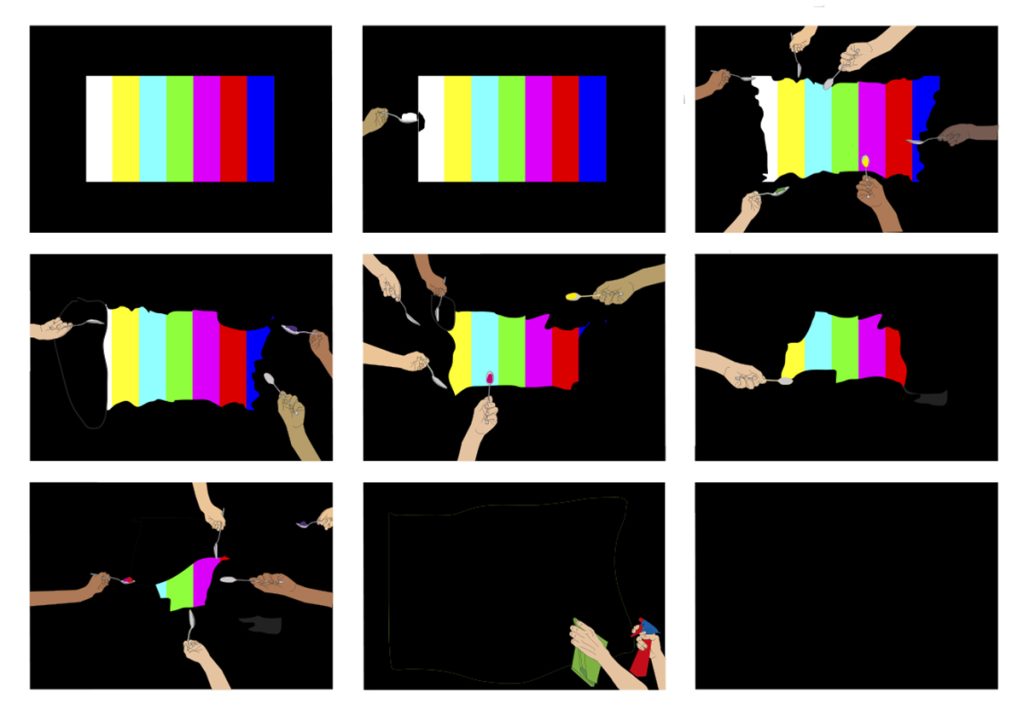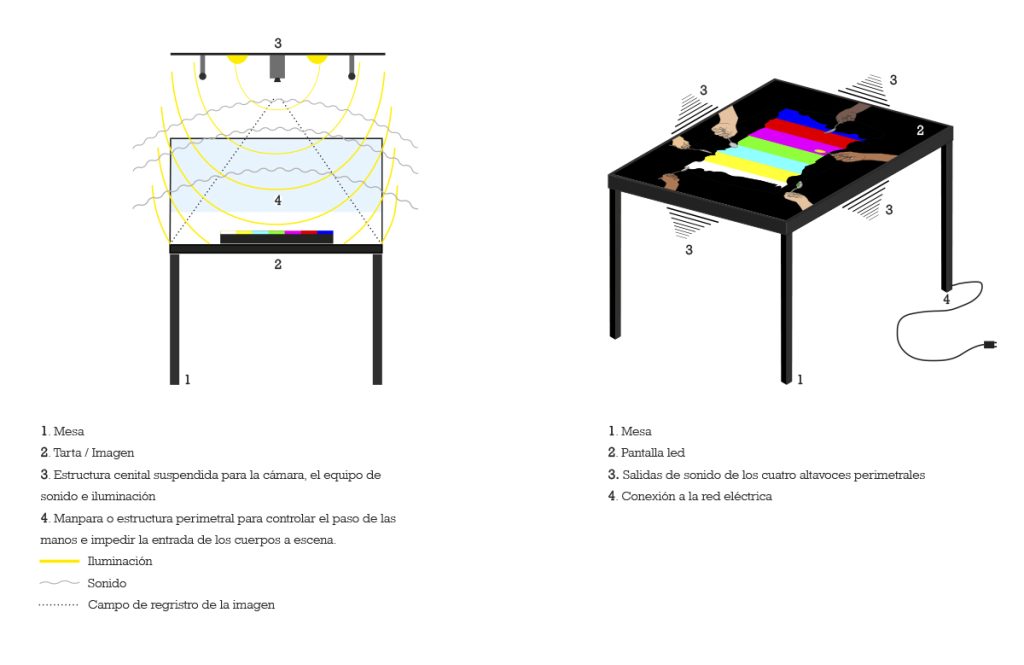
Si una imagen vale más que mil palabras, qué valor tendrá entonces una imagen que es patrón visual y espejo donde se miran y calibran las propias imágenes. Cuántos significados contendrá.
Instrospective es la grabación cenital en plano secuencia de una performance. Diálogo teatralizado, y ensayo visual, entre la voz propia, la cita y la apropiación alrededor de una tarta alegórica* que unos comensales fuera de plano se meriendan hasta hacerla desaparecer, fundiendo todo a negro, mientras toman té, escuchan otras voces y discuten acerca del status, el significado y la naturaleza de todas las imágenes.
* Imagen de una carta de ajuste
If a picture is worth a thousand words, then what value will an image have as a visual standard and a mirror in which the images themselves are looked at and calibrated? How many meanings it will contain.
Instrospective is the zenithal sequence shot of a performance. Theatricalised dialogue, and visual rehearsal, between self-voice, quotation and appropriation around an allegorical cake* that out-of-plane diners eat until it disappears, melting everything to black, while drinking tea, listening to other voices and discussing the status, meaning and nature of all images.
* Image of an adjustment chart

1. Por qué Introspective
Una imagen, un espejo y un paisaje son objetos íntimamente relacionados. Espacios bidimensionales, volumétricos o adimensionales que nos devuelven nuestra propia imagen física y emocional: el cuerpo, los recuerdos, experiencias y sensaciones almacenadas en nuestra memoria. Son, en definitiva, el bagaje personal y la más insondable conciencia que nos define; medida y reflejo no solo de lo que somos, sino también de lo que proyectamos.
El poder de las imágenes no surge de la nada, se revela, cobra cuerpo. Cada una de ellas es como un pozo sin fondo, una cadena de acontecimientos que se desborda inconscientemente. Cuando manipulamos un objeto, miramos una imagen o habitamos un espacio, nos proyectamos, sobre todo, para comprender donde nos situamos en relación con nuestro espacio físico y mental. Nos calibramos, reorganizamos nuestra memoria, nuestros pensamientos, nuestros recuerdos, en un acto reflejo, mecánico e inconsciente, cargado de subjetividad, preguntas y curiosidad, pero también prejuicios, y miedos.
Pero, ¿Somos realmente conscientes y críticos con la realidad que se nos muestra, y mostramos, o simplemente permanecemos hipnotizados ante esos reflejos especulares? ¿Cómo miramos y nos relacionamos con esas pantallas que son referente de nuestro imaginario visual? ¿Son superficies residuales, cuerpos inertes o con conciencia? ¿Condensan todo sobre lo que sobre ellas se emite o se proyecta?
Estas preguntas subyacen y han sido recurrentes en mis trabajos en video. Proyectos que en su conjunto reflexionan sobre el significado de las imágenes, su proceso de consolidación mental, y sobre la pantalla como receptora y emisora, contenedor y contenido.
Así, Introspective, a través de un ritual colectivo y de un relato no lineal plagado de figuras retóricas y voces invitadas, pone literalmente sobre la mesa las ambivalencias, contradicciones y juegos entre la palabra y la imagen, profundizando sin barreras estéticas, ideológicas ni dogmas, y desde la certeza, la hipótesis, la ironía y la paradoja sobre todas estas cuestiones, planteando al mismo tiempo nuevos interrogantes sobre el hecho de cómo nos relacionamos con las imágenes y las pantallas con respecto a qué y a quiénes.
1. Why Introspective
An image, a mirror and a landscape are closely related objects. Two-dimensional, volumetric or dimensionless spaces that give us back our own physical and emotional image: the body, the memories, experiences and sensations stored in our memory. They are, in short, the personal baggage and the most unfathomable consciousness that defines us; a measure and reflection not only of what we are, but also of what we project.
The power of images does not come out of nowhere, it reveals itself, it takes shape. Each one of them is like a bottomless pit, a chain of events that unconsciously overflows. When we handle an object, look at an image or inhabit a space, we project ourselves, above all, to understand where we are in relation to our physical and mental space. We calibrate ourselves, reorganise our memory, our thoughts, our memories, in a reflex, mechanical and unconscious act, loaded with subjectivity, questions and curiosity, but also prejudices and fears.
But are we really conscious and critical of the reality we are shown, and show, or do we simply remain hypnotised before these specular reflections? How do we look at and relate to these screens that are the referents of our visual imaginary? Are they residual surfaces, inert bodies or bodies with consciousness? Do they condense everything that is emitted or projected onto them?
These questions underlie and have been recurrent in my video works. Projects that as a whole reflect on the meaning of images, their process of mental consolidation, and on the screen as receiver and transmitter, container and content.
Thus, Introspective, through a collective ritual and a non-linear narrative full of rhetorical figures and invited voices, literally puts on the table the ambivalences, contradictions and games between word and image, delving without aesthetic, ideological or dogmatic barriers, and from certainty, hypothesis, irony and paradox on all these issues, while raising new questions about how we relate to images and screens with respect to what and to whom.

2. Instrospective forma y contenido
Introspective en su concepción formal y narrativa sigue la estela del resto de mis videoperformances. Se trata de un plano cenital, secuencia de una acción banal, repetitiva, lúdica y expansiva, protagonizada en esta ocasión por un número indeterminado de performers; asistentes e invitados a una merienda/fiesta colectiva que se celebra fuera de plano, en una elipsis sin fin.
Su puesta en escena, y la posterior formalización de la obra que replica el set de grabación , implica un manejo escenográfico en la suspensión del sujeto creador, pues el espectador durante su visionado ocupará el mismo espacio que los anónimos ejecutores de la acción. Y, al acercarse a la mesa, se proyectará físicamente sobré el negro de la pantalla, mientras que -mirando y observando hacia adentro, así mismo- se preguntará dónde se encuentra ante lo que sucede, lo que se cuenta y se relata
Su estructura narrativa sin clímax -pues el desarrollo de la acción monótona y repetitiva no deja lugar a dudas de su desenlace final, acabar con la tarta hasta fundir la imagen a negro- desplazará el peso narrativo de la acción al relato, del espacio representado hacia otros lugares dentro y fuera de plano. Al mismo tiempo lo que vemos serápura metáfora de cómo consumimos con la mirada, y la imagen que se consume una carta de ajuste; patrón visual de todas las imágenes. En resumen, un bucle, y un juego continuo de espejos visuales y narrativos que se proyectan sobre sí mismos.
Esa narración -ese relato sobre la historia, el significado y el poder de las imágenes- será ficcionado. Una suerte de ensayo narrativo, o metarrelato colectivo, creado y montado con el propio sonido directo de la acción, fragmentos de audio de otros materiales audivisuales, citas, reflexiones y apropiaciones que aportarán el propio artista y todos los invitados a la fiesta, incluido el equipo técnico.
El resultado final será un texto, una conversación que crecerá de forma orgánica, rizomática, expansiva, como un arbusto, y donde el azar, el encuentro inesperado, las narraciones paralelas, lo irónico, lo lúdico y lo reflexivo estarán en diálogo constante. Perspectivas y lecturas también presentes en la imagen y la acción registrada.
2. Instrospective form and content
Introspective in its formal and narrative conception follows in the wake of the rest of my videoperformances. It is a zenithal shot, a sequence of a banal, repetitive, playful and expansive action, starring on this occasion an indeterminate number of performers; attendees and guests at a collective snack/party that takes place out of shot, in an endless ellipsis.
Its staging, and the subsequent formalisation of the work that replicates the recording set (fig1/2), implies a scenographic handling in the suspension of the creative subject, as the spectator during its viewing will occupy the same space as the anonymous executors of the action. And, on approaching the table, he or she will be physically projected onto the black of the screen, while – looking and observing inwards, likewise – he or she will wonder where he or she is in the face of what is happening, what is being told and recounted.
Its narrative structure without climax – for the development of the monotonous and repetitive action leaves no room for doubt as to its final outcome, to finish off the cake until the image fades to black – will shift the narrative weight from the action to the story, from the space represented to other places in and out of shot. At the same time, what we see will be a metaphor for how we consume with our gaze, and the image that is consumed will be an adjustment chart; the visual pattern of all images. In short, a loop, and a continuous play of visual and narrative mirrors that are projected onto themselves.
That narrative – that account of the history, meaning and power of images – will be fictionalised. A sort of narrative essay, or collective meta-narrative, created and assembled with the direct sound of the action itself, audio fragments from other audiovisual materials, quotes, reflections and appropriations contributed by the artist himself and all the guests at the party, including the technical team.
The final result will be a text, a conversation that will grow organically, rhizomatically, expansively, like a bush, and where chance, unexpected encounters, parallel narratives, irony, playfulness and reflection will be in constant dialogue. Perspectives and readings also present in the image and the action recorded.

3. Introspective una imagen/tarta
A la hora de decidir qué imagen nos comeríamos, desde un principio tuve claro que no sería figurativa. Volví a mis cuadernos de trabajo, donde guardo, colecciono y acumulo una gran variedad de referencias, textos e imágenes, y en ese proceso me vino a la memoria la portada del álbum “Introspective” de Pet Shop Boys, disco del que este proyecto toma su título prestado. Se trataba de una imagen íntima, pero abstracta, construida con barras de colores verticales parecida a un arcoíris, de nuevo el paisaje,y parecida a la bandera LGTtQ+..
Dibujé la portada en mi cuaderno, reflexioné y escribí sobre la idea del proyecto, lo presenté en una exposición sobre procesos, y en ese devenir, buscando en internet, llegué hasta la carta de ajuste de Tele 5, y ahí supe que la había encontrado. Una imagen anacrónica, que nos habla de la velocidad y la obsolescencia de la tecnología, íntima en mis referencias personales y colectivas, y espejo donde se miran y calibran las propias imágenes.
El hecho de convertirla en una tarta, y esa tarta de nuevo en una imagen que literalmente se consume en un acto de glotonería, es una clara metáfora sobre nuestra relación con las pantallas, y las imágenes que estas emiten sin cesar. Reflejos espectrales, sin cuerpo pero con entidad mutante, que se han convertido en el espacio que habitamos, y el paisaje en el que nos movemos.
La tarta negra de bizcocho relleno con sabores sorpresa, uno por color, reproducirá en su superficie impresa en papel comestible una carta de ajuste sin el negro, ya presente en el fondo de la mesa/pantalla
4. Instrospective una mesa tarta
Una mesa nos invita a la acción. Dispuestos a su alrededor, nos disponemos a experimentar casi siempre en compañía; charlamos, comemos, discutimos, nos reímos o debatimos. Pero también es un objeto para disfrutar desde la soledad y la introspección; dibujamos, leemos, proyectamos o escribimos. Lo público y lo privado coexisten en su forma de uso.
Una mesa es un elemento primordial en la definición del espacio, y también en este proyecto. Un dispositivo que activa la relaciones a su alrededor, reúne a todos entorno suyo, unidos y a la vez separados por ese objeto.
Al utilizarla como elemento vertebrador de la acción registrada en el video, y al volverla a reutilizar replicando el set de grabación como display expositivo, se reactiva para el público, estableciendo nuevas interconexiones, relaciones, y posibles diálogos entre los activadores de la pieza.
3. Introspective an image/cake
When it came to deciding which image we would eat, it was clear to me from the start that it would not be figurative. I went back to my work notebooks, where I keep, collect and accumulate a wide variety of references, texts and images, and in the process I remembered the cover of the Pet Shop Boys’ album Introspective, the album from which this project borrows its title. It was an intimate, but abstract image, constructed with vertical colour bars resembling a rainbow, again the landscape, and resembling the LGTtQ+ flag….
I drew the cover in my notebook, I reflected and wrote about the idea of the project, I presented it in an exhibition about processes, and in this process, searching the internet, I came across the Tele 5 adjustment chart, and that’s when I knew I had found it. An anachronistic image, which speaks to us of the speed and obsolescence of technology, intimate in my personal and collective references, and a mirror in which the images themselves are looked at and calibrated.
The fact of turning it into a cake, and that cake again into an image that is literally consumed in an act of gluttony, is a clear metaphor for our relationship with screens, and the images that they endlessly emit. Spectral reflections, disembodied but with a mutant entity, that have become the space we inhabit, and the landscape in which we move.
The black sponge cake filled with surprise flavours, one per colour, will reproduce on its surface printed on edible paper an adjustment chart without the black, already present in the background of the table/screen.
4. Instrospective a cake table
A table invites us to action. Arranged around it, we are almost always ready to experiment in company; we chat, eat, discuss, laugh or debate. But it is also an object to be enjoyed in solitude and introspection; we draw, read, project or write. The public and the private coexist in the way it is used.
A table is a primordial element in the definition of space, and also in this project. A device that activates the relationships around it, bringing everyone together around it, united and at the same time separated by this object.
By using it as the backbone of the action recorded in the video, and reusing it by replicating the recording set as an exhibition display, it is reactivated for the public, establishing new interconnections, relationships and possible dialogues between the activators of the piece.

5. Plan de rodaje
La grabación de Introspective se realizará durante una fiesta. La organización de dicho evento, la lista de invitados, la logística, la producción y el guion de rodaje se determinarán y se elaborarán una vez concedida la beca.
Indispensable para asistir a la fiesta será aportar una imagen, un texto, un vídeo, un libro, una referencia, un escrito, una cita, un fragmento… sobre la historia, el status, el significado, el ser de las imágenes, sus verdades o mentiras, sus contradicciones… sobre la memoria, los recuerdos, los proyectos y experiencias pasados, futuros, inventados, recreados, vividos o por venir.
Posteriormente,con todo ese material, se escribirá un guion y una escaleta de rodaje que será interpretado por los invitados a la fiesta, pero que también estará abierto a la improvisación y el azar durante la celebración y la performance.
6. Conclusión
“Introspective” se plantea, pues, como una exploración de lo visual desde lo que no se ve, pero se oye, se intuye o se imagina; sobre la imagen como horizonte, límite y frontera entre lo real y lo imaginado. Relato múltiple, contado a partir de una serie de narraciones que discurrirán en paralelo a una secuencia lineal y simétrica, sin clímax, donde el peso del relato está fuera, en la mirada del que observa.
Cuando todo a nuestro alrededor se mueve a un ritmo de vértigo, este proyecto nos propone un mirar hacia adentro, una pausa necesaria, olvidada. Recuperar la mirada reflexiva, la parada física frente a una pantalla, pero también introspectiva.
Acordarnos, en suma, que dentro de nosotros, y de las imágenes que miramos, o decidimos no mirar porque nos aterran, habitamos nosotros mismos, y todos los demás.
Porque divagar, dejarse llevar y perder la conciencia ante una pantalla es casi un ejercicio subversivo; un deleite sublime, y en este caso también un viaje sin rumbo por la historia de las imágenes.
5. Filming schedule
The filming of Introspective will take place during a party. The organisation of the event, the guest list, the logistics, the production and the shooting script will be determined and worked out after the grant has been awarded.
In order to attend the party, it is essential to bring an image, a text, a video, a book, a reference, a piece of writing, a quote, a fragment… about the history, the status, the meaning, the being of the images, their truths or lies, their contradictions… about memory, memories, projects and experiences, past, future, invented, recreated, lived or to come.
Subsequently, with all this material, a script and a shooting schedule will be written, which will be interpreted by the guests at the party, but which will also be open to improvisation and chance during the celebration and the performance.
6. Conclusion
«Introspective» is therefore conceived as an exploration of the visual from what is not seen, but heard, sensed or imagined; about the image as horizon, limit and frontier between the real and the imagined. A multiple story, told from a series of narratives that run parallel to a linear and symmetrical sequence, without climax, where the weight of the story is outside, in the gaze of the observer.
When everything around us is moving at a dizzying pace, this project proposes a look inwards, a necessary, forgotten pause. To recover the reflective gaze, the physical pause in front of a screen, but also the introspective one.
To remember, in short, that within ourselves, and within the images we look at, or decide not to look at because they terrify us, we inhabit ourselves, and everyone else.
Because to wander, to let ourselves go and lose consciousness in front of a screen is almost a subversive exercise; a sublime delight, and in this case also an aimless journey through the history of images.